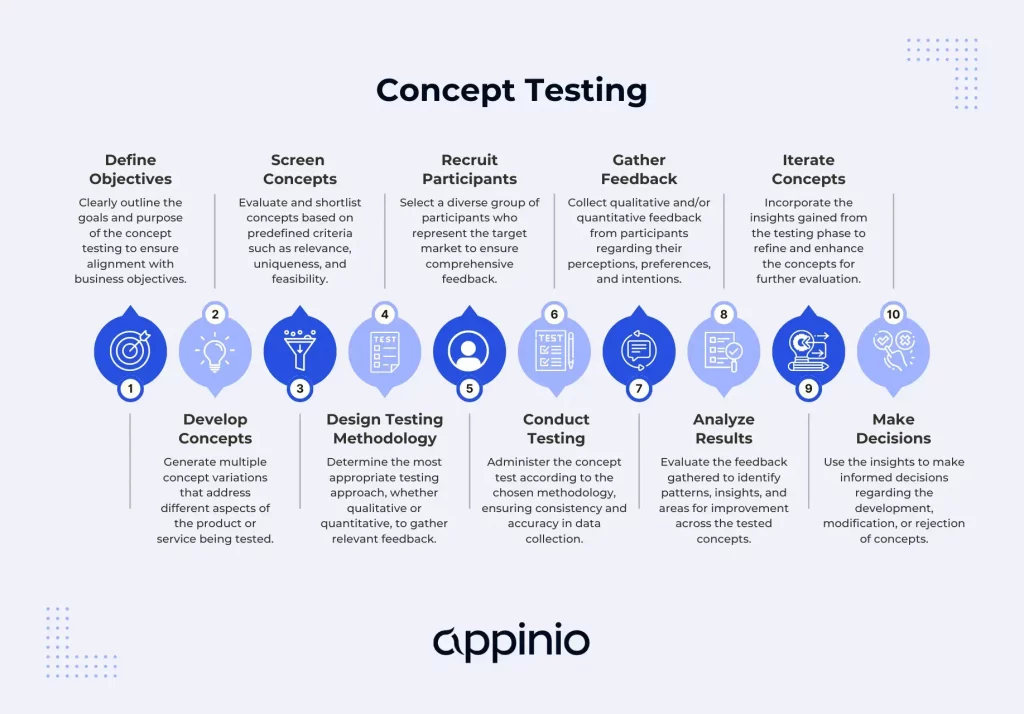In today’s fast-paced market, where consumer preferences shift rapidly and competition is fierce, launching a new product can feel like a high-stakes gamble. Did you know that a staggering 95% of new products fail within their first year on the market? This sobering statistic underscores a critical truth: great ideas alone don’t guarantee success. Enter concept testing – the unsung hero of product development that can dramatically tip the scales in your favor.
What Is Concept Testing?
At its core, concept testing is the process of using surveys and other research methods to evaluate consumer acceptance of a new product idea before it enters the market. But it’s so much more than just asking people if they like something. Concept testing is about diving deep into the psyche of your target audience, understanding their needs, preferences, and pain points, and using that information to refine and optimize your offering.
Imagine you’re a chef preparing to open a new restaurant. You wouldn’t just create a menu based on your personal tastes and hope for the best. Instead, you’d likely invite a select group to taste your dishes, gathering feedback on flavors, presentation, and overall experience. Concept testing follows a similar principle but for products and services across all industries.
This process allows companies to:
- Validate the core idea behind a product
- Identify potential improvements or modifications
- Understand how the product fits into the market landscape
- Gauge potential demand and pricing strategies
- Refine marketing messages for maximum impact
By engaging in concept testing, businesses can significantly reduce the risk associated with new product launches, saving time, money, and reputation in the process.
Benefits of Concept Testing
The advantages of incorporating concept testing into your product development cycle are numerous and far-reaching. Let’s explore some of the key benefits:
Prevents Costly Mistakes
By identifying potential issues early in the development process, you can avoid expensive post-launch corrections. It’s much cheaper to tweak a concept than to recall or significantly modify a product that’s already on the market.
Saves Time and Resources
Concept testing allows you to focus your efforts on ideas with the highest potential for success. Instead of spreading resources thin across multiple concepts, you can allocate them more efficiently to the winners.
Improves Product-Market Fit
Through direct feedback from your target audience, you gain deep insights into what your customers truly want and need. This information is invaluable in creating a product that resonates with your market.
Informs Marketing Strategies
Discover which features and benefits resonate most with your audience. This knowledge can shape your marketing messages, ensuring they hit the right notes with potential customers.
Reduces Launch Risks
Enter the market with confidence, backed by data-driven decisions. Concept testing provides a level of assurance that your product has been vetted by its intended audience.
Provides Stakeholder Buy-in
Use concrete evidence to convince investors, partners, and internal stakeholders of your concept’s viability. Data from concept testing can be a powerful tool in securing support and resources for your project.
Uncovers Unexpected Insights
Often, concept testing reveals surprising information about your audience or product that you hadn’t considered. These insights can lead to innovative features or entirely new product ideas.
Optimizes Pricing Strategies
Gauge how much consumers are willing to pay for your product, helping you set a price point that balances profitability with market acceptance.
Concept Testing Methods
There are several methods of concept testing, each with its own strengths and ideal use cases. The choice of method often depends on your specific goals, resources, and the nature of your product. Here are the primary concept testing methods:
Comparison Testing
In this method, you present multiple concepts to your audience and ask them to compare and choose between them. This is particularly useful when you have several strong ideas and need to determine which one to pursue.
Pros:
- Clearly identifies preferences between options
- Simulates real-world decision-making processes
Cons:
- May not provide in-depth feedback on individual concepts
- Can be influenced by order bias
Monadic Testing
This involves presenting a single concept to each participant for thorough evaluation. It allows for a deep dive into the strengths and weaknesses of a particular idea.
Pros:
- Provides detailed feedback on a single concept
- Avoids comparison bias
Cons:
- Requires a larger sample size for multiple concepts
- Can be more time-consuming and expensive
Sequential Monadic Testing
Participants evaluate multiple concepts in a randomized order, providing feedback on each. This method combines the depth of monadic testing with the comparative aspect of comparison testing.
Pros:
- Allows for both individual concept evaluation and comparison
- Reduces order bias through randomization
Cons:
- Can be lengthy, potentially leading to participant fatigue
- May require a larger sample size for reliable results
Protomonadic Testing
This hybrid approach starts with individual concept evaluations (like monadic testing) and then asks participants to choose their overall preference. It provides both detailed feedback and clear preference data.
Pros:
- Offers comprehensive insights on individual concepts and overall preferences
- Allows for consistency checks between evaluations and final choice
Cons:
- Can be complex to design and analyze
- May be more time-consuming for participants
How to Do Concept Testing
Concept testing is a crucial process that requires careful planning and execution. Let’s dive into each step of the process in detail:
1. Define Your Objectives
Start by clearly outlining what you aim to learn from the testing process. Your objectives will guide the entire process, so it’s crucial to be specific. Ask yourself:
- Are you trying to choose between multiple concepts?
- Do you need to refine a single idea?
- Are you looking to understand pricing sensitivity?
- Do you want to gauge the market’s reaction to a new feature?
Clear objectives might include:
- Determining which of three product designs resonates most with the target audience
- Assessing whether a new feature justifies a price increase
- Identifying which product benefits are most appealing to potential customers
2. Identify Your Target Audience
Determining who your ideal customers are is critical for meaningful concept testing. Consider:
- Demographics: Age, gender, income level, education, occupation
- Psychographics: Lifestyle, values, interests, attitudes
- Behaviors: Purchasing habits, brand preferences, product usage patterns
Use market research, customer data, and buyer personas to define your target audience precisely. Remember, testing with the wrong audience can lead to misleading results.
3. Choose Your Testing Method
Based on your objectives and resources, select the approach that best suits your needs. Consider factors like:
- The number of concepts you’re testing
- The depth of feedback required
- Your timeline and budget
- The stage of product development
Methods to choose from include:
- Comparison Testing
- Monadic Testing
- Sequential Monadic Testing
- Protomonadic Testing
Each method has its strengths and weaknesses, so align your choice with your specific goals and constraints.
4. Develop Your Concept Testing Survey
Crafting an effective survey is crucial for gathering valuable insights. Your survey should cover:
- Overall appeal of the concept
- Uniqueness and differentiation
- Relevance to consumer needs
- Purchase intent
- Pricing perceptions
- Potential improvements
Use a mix of question types:
- Closed-ended questions for quantitative data (e.g., Likert scales, multiple choice)
- Open-ended questions for qualitative insights
Pro Tip: Keep your survey focused and not too lengthy to prevent respondent fatigue.
5. Create Clear Concept Descriptions
Develop clear, concise descriptions of your concept(s). These should be easily understandable by your target audience and include:
- Key features and benefits
- Visual representations (images, diagrams, or prototypes)
- Pricing information (if relevant to your testing goals)
Ensure your descriptions are consistent across all concepts if you’re testing multiple ideas. Avoid using technical jargon unless your target audience is highly specialized.
6. Conduct a Pilot Test
Before launching your full study, run a small pilot test to identify any issues with your survey or concept descriptions. This can save you from costly mistakes in the main study. In your pilot:
- Test with a small group (10-20 people) from your target audience
- Ask for feedback on the clarity of questions and concept descriptions
- Check if the data you’re collecting aligns with your objectives
- Estimate the time it takes to complete the survey
Use the pilot test results to refine your survey and concept descriptions as needed.
7. Launch Your Concept Test
Implement your chosen method and gather data from your target audience. Ensure you’re reaching a representative sample of your market. Consider:
- Using online survey platforms for wider reach
- Employing market research firms for more controlled environments
- Leveraging your existing customer base if appropriate
Monitor the data collection process to ensure you’re getting quality responses and meeting your sample size goals.
8. Analyze Results
Once the data is collected, it’s time to dig in. Look for:
- Patterns and trends in the quantitative data
- Themes and insights in the qualitative feedback
- Differences in responses across demographic segments
- Any surprising or unexpected findings
Use statistical analysis for quantitative data and content analysis for qualitative feedback. Consider using data visualization tools to help identify patterns and communicate findings effectively.
9.Iterate and Improve
Use the findings to refine your concept. This might involve:
- Tweaking features based on customer feedback
- Adjusting messaging to better communicate key benefits
- Reconsidering pricing strategies
- Pivoting to an entirely new direction based on consumer insights
Document your changes and the rationale behind them for future reference.
10. Consider Additional Testing
If significant changes are made, or if new questions arise from your initial test, consider conducting another round of testing to validate your improvements. This iterative process can help you refine your concept until it’s truly market-ready.Pro Tip: While traditional concept testing methods provide valuable insights, platformslike Prelaunch can uncover unexpected insights beyond conventional testing. By leveraging AI and advanced analytics, Prelaunch’s customer insights feature can help you dive deeper into consumer behavior and preferences, providing a more comprehensive understanding of your market.Concept test surveys are the best way to gather important and valuable insight that will put you on a path to success.

Concept Testing Examples
Agwa’s AI-Assisted Home Gardening Solution

Agwa, a home gardening solution company, partnered with Prelaunch.com to test two product versions: a smaller 2-shelf model ($599) and a larger 3-shelf model ($790). Traditional research suggested preference for the smaller version, but Prelaunch’s “skin in the game” approach revealed stronger buying intent for the larger model.
The study uncovered key motivations like hassle-free fresh greens and healthier eating habits. It also revealed unexpected insights, such as interest from fishing enthusiasts and rabbit owners. Prelaunch’s method provided stronger opinions on feature importance compared to traditional surveys.
This data-driven approach allowed Agwa to confidently focus on the larger model, understand customer motivations for targeted marketing, and explore new market segments. The case highlights the value of concept testing that goes beyond surface-level preferences to uncover actionable insights.
Coca-Cola’s New Coke Fiasco

In 1985, Coca-Cola launched “New Coke,” replacing its classic formula. Despite extensive concept testing involving 200,000 blind taste tests where the new formula consistently outperformed both Pepsi and the original Coke, the product failed spectacularly in the market.
The concept testing failed to account for the emotional attachment consumers had to the original Coca-Cola. While people preferred the sweeter taste in blind tests, they rejected the idea of replacing the classic Coke they had grown up with.
This case demonstrates the importance of testing not just the product itself, but also its broader implications and emotional impact on consumers. It highlights the need for concept testing to go beyond simple preference metrics and consider brand loyalty, tradition, and consumer sentiment.
Airbnb’s Photography Program

In 2009, Airbnb was struggling with low booking rates. The team hypothesized that low-quality photos of listings were a major factor. To test this concept, they rented a camera, took high-quality pictures of New York listings, and A/B tested these against the original photos.
The results were dramatic: listings with professional photos saw booking rates 2-3 times higher than those without. This simple concept test led to a professional photography program that became a cornerstone of Airbnb’s success.
This example shows how concept testing can be applied not just to products, but to features and services as well. It also demonstrates the power of testing a simple hypothesis and how the insights gained can lead to significant business improvements.
These diverse examples illustrate how concept testing can be applied across various industries and scenarios, from physical products to digital services. They also highlight the importance of considering multiple factors in concept testing, including emotional responses, user experience, and practical implementation.
Conclusion: Embracing the Power of Concept Testing
Concept testing is not just a step in product development—it’s a crucial investment in your product’s future. By leveraging consumer insights, you can:
- Dramatically increase your chances of market success
- Save valuable resources
- Create products that truly resonate with your target audience
Remember, concept testing isn’t about stifling creativity; it’s about combining innovative ideas with real-world feedback. This powerful tool can be the difference between being part of the 95% of products that fail and the successful 5% that thrive.
As you embark on your next product development journey, make concept testing your secret weapon. In a world of ever-evolving consumer preferences and fierce competition, can you afford not to test your concepts?
FAQs
Q: What’s the difference between concept testing and usability testing?
A: While both are important in product development, they serve different purposes. Concept testing evaluates the overall idea or features of a product before development, focusing on market potential and consumer interest. Usability testing, on the other hand, assesses how easy and intuitive a product is to use after it’s been developed, often involving prototypes or beta versions of the product.
Q: How long should a concept test take?
A: The duration can vary widely depending on the complexity of the concept, the chosen testing method, and the sample size. Typically, a concept test can take anywhere from a few days to several weeks. Simple online surveys might be completed in a matter of days, while more comprehensive studies involving multiple rounds of testing could take a month or more.
Q: How much does concept testing cost?
A: Costs can range from a few hundred dollars for simple surveys to tens of thousands for comprehensive studies involving large sample sizes or complex methodologies. Factors influencing cost include the testing method, sample size, recruitment costs, and analysis complexity. While it may seem expensive, the investment often pays for itself by preventing costly mistakes and ensuring product-market fit. Remember, the cost of concept testing is typically far less than the potential losses from launching an unsuccessful product.




